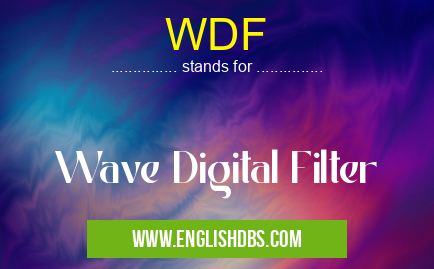What does WDF mean in UNCLASSIFIED
WDF stands for Wave Digital Filter. It is a type of digital filter that is used to process audio signals. Unlike traditional digital filters, which are implemented using finite impulse response (FIR) or infinite impulse response (IIR) filters, WDFs are based on the concept of wave variables. This allows WDFs to be implemented with a high degree of accuracy and efficiency, making them ideal for use in demanding applications such as audio synthesis and signal processing.

WDF meaning in Unclassified in Miscellaneous
WDF mostly used in an acronym Unclassified in Category Miscellaneous that means Wave Digital Filter
Shorthand: WDF,
Full Form: Wave Digital Filter
For more information of "Wave Digital Filter", see the section below.
Key Features of WDFs
- Accuracy: WDFs are very accurate, even at high frequencies.
- Efficiency: WDFs are very efficient, even when implementing complex filters.
- Stability: WDFs are very stable, even when used in feedback loops.
- Flexibility: WDFs can be used to implement a wide variety of filter types, including low-pass, high-pass, band-pass, and band-stop filters.
Advantages of WDFs
- Lower computational complexity: WDFs can be implemented with a lower computational complexity than traditional digital filters, making them ideal for use in real-time applications.
- Higher accuracy: WDFs can achieve a higher accuracy than traditional digital filters, especially at high frequencies.
- Greater flexibility: WDFs can be used to implement a wider variety of filter types than traditional digital filters.
Applications of WDFs
WDFs are used in a variety of applications, including:
- Audio synthesis: WDFs are used to synthesize a wide variety of musical sounds.
- Signal processing: WDFs are used to process audio signals in a variety of ways, such as filtering, equalization, and compression.
- Control systems: WDFs are used to control the behavior of physical systems, such as robots and motors.
Essential Questions and Answers on Wave Digital Filter in "MISCELLANEOUS»UNFILED"
What is a Wave Digital Filter (WDF)?
A WDF is a type of digital filter that models the behavior of analog filters using discrete-time wave variables. It is based on the principle of wave propagation, where signals are represented as waves traveling through a network of interconnected components.
What are the advantages of WDFs over traditional digital filters?
WDFs offer several advantages, including:
- Physically meaningful representation: They model the behavior of analog filters more closely, making them intuitive to design and analyze.
- Stability and efficiency: WDFs are inherently stable and can be implemented efficiently in real-time applications.
- Modularity and scalability: WDFs can be easily interconnected and scaled to create complex filter structures.
How are WDFs implemented?
WDFs are typically implemented using a block-based approach, where each block represents a specific filter component, such as a resistor, capacitor, or inductor. The blocks are interconnected using waveguides, which represent the signal paths.
What are the applications of WDFs?
WDFs find applications in various areas, including:
- Audio signal processing: Creating equalizers, compressors, and other audio effects.
- Control systems: Designing controllers and filters for industrial and aerospace applications.
- Acoustics: Simulating the propagation of sound waves in different environments.
- Musical instrument modeling: Creating virtual instruments that accurately replicate the sound of real instruments.
Final Words: WDFs are a powerful type of digital filter that offer a number of advantages over traditional digital filters. Their accuracy, efficiency, stability, and flexibility make them ideal for use in a variety of demanding applications.
